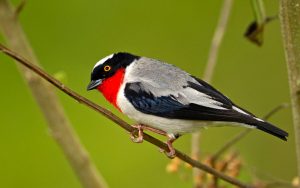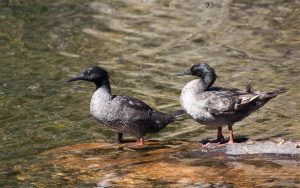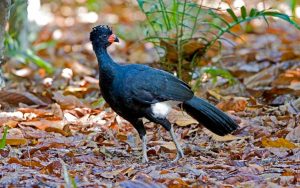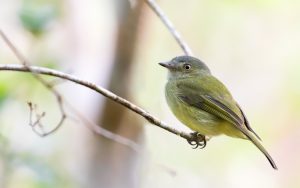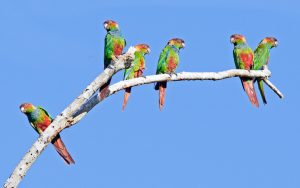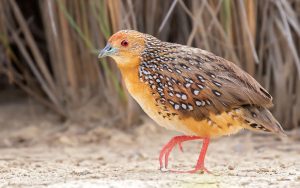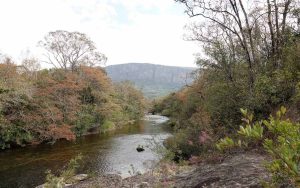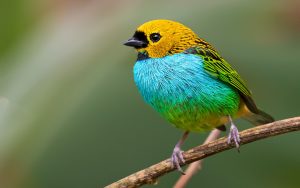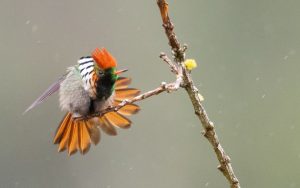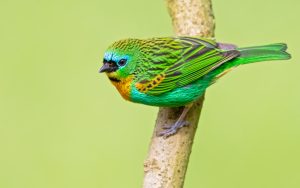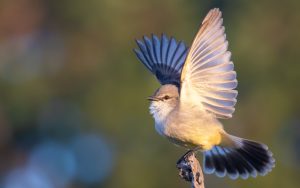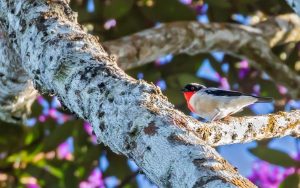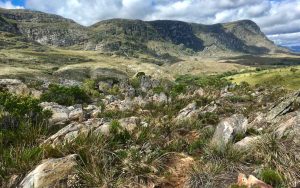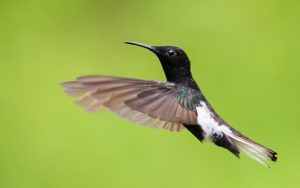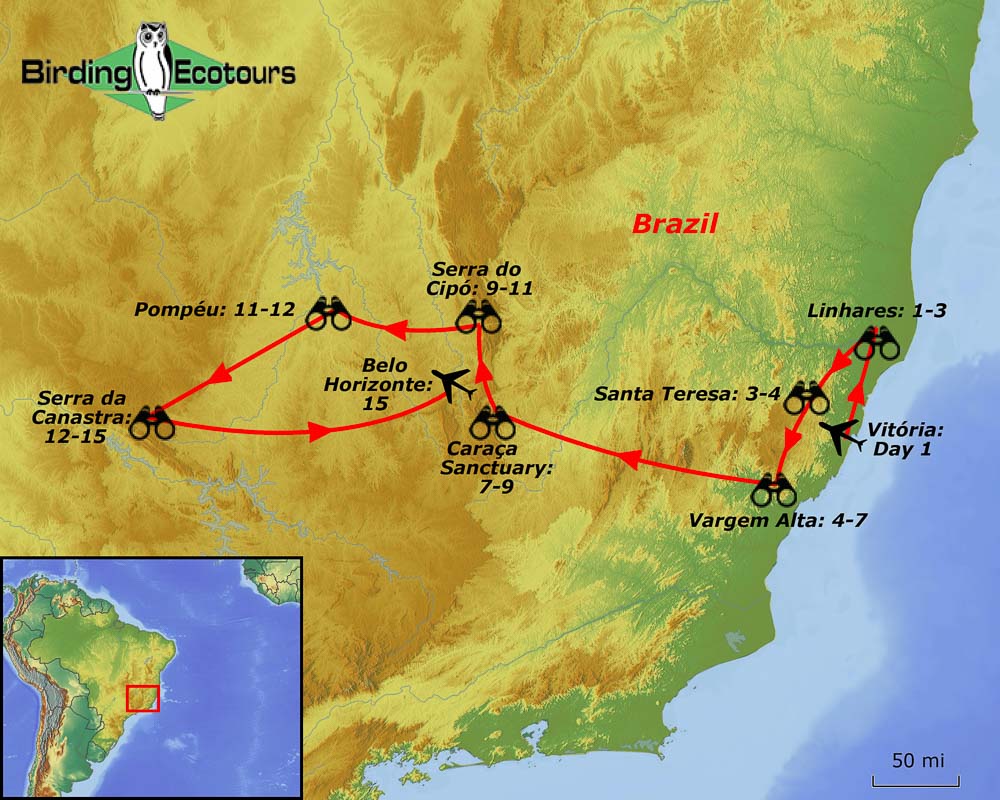Birding Tour Brazil: Espirito Santo & Minas Gerais Birding Tour
Go to: Brazil Birding Tours | Birding Tours in the Neotropics | All our birding tours
Birding Tour Brazil: Espirito Santo and Minas Gerais Birding Tour September 2026
By participating in the 2025 tour you will help to raise funds for Neotropical Birding and Conservation (NBC). NBC makes research grants to those seeking to conserve endangered neotropical birds such as Cherry-throated Tanager.
This exciting southeast Brazilian birding tour is specifically designed around finding a number of rarely seen, range-restricted specials in the Brazilian states of Espirito Santo and Minas Gerais. Starting out, we concentrate on a few rarities of the Southeastern Atlantic Coastal Lowland Forest (in Linhares) including the highly desired Red-billed Curassow. We then go after other Espirito Santo Atlantic Forest rarities, such as the ultra-rare Cherry-throated Tanager. After crossing beautiful landscapes and habitats in search of Cerrado and campo rupestre specials, we end our trip in the Cerrado of Serra da Canastra, enjoying Brazilian Merganser and various Cerrado birds. We also hope to find some iconic mammals such as Maned Wolf on this Brazilian birding tour.
Let’s hope for the best of luck on this exciting Brazilian birding adventure!
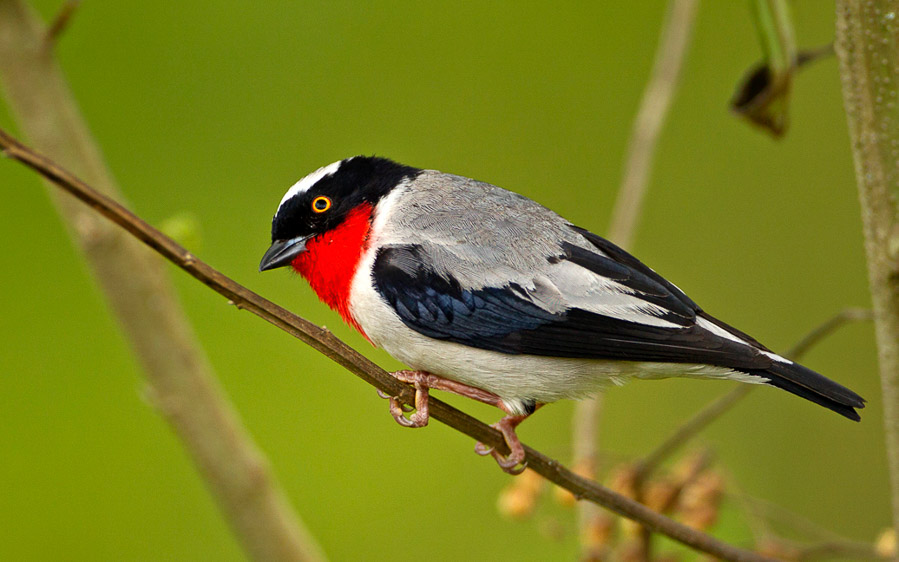
Detailed Itinerary (15 days / 14 nights)
Day 1. Transfer from Vitória to Linhares
Today we will have a roughly 2.5-hour transfer (80 miles/~130 kilometers) from Vitória to reach Linhares, ready for our early morning birding the next day.
Overnight: Linhares
Day 2. Birding in Linhares (Vale Private Reserve)
The Vale Private Reserve and adjacent state-owned Sooretama Biological Reserve protect the largest remnant of Brazil’s Southeastern Atlantic Coastal Lowland Rainforest. This area is one of the few remaining sites for one of the world’s rarest cracids, the Red-billed Curassow, and holds the species’ largest population. We will mostly bird along the many roads that cut through the reserve.
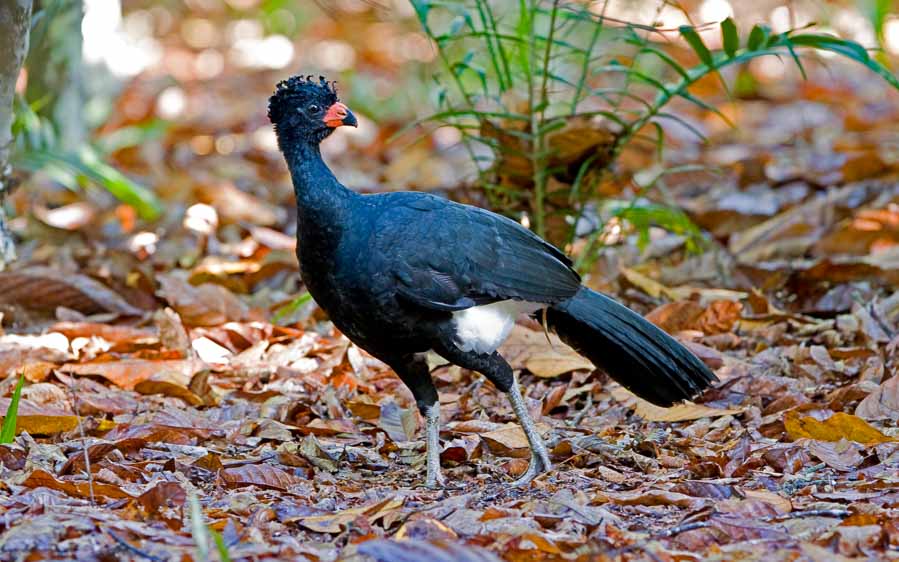
Without a doubt, our main target here will be the rare and range-restricted Red-billed Curassow. Other interesting species we could find here include Ochre-marked and White-eared Parakeets, Red-browed Amazon, Black-headed Berryeater, East Brazilian Pygmy Owl, Minute Hermit, Black-necked Aracari, Ringed and Red-stained Woodpeckers, Sooretama Slaty Antshrike, Screaming Piha, Red-headed and White-crowned Manakins, Brown-winged Schiffornis, Greyish Mourner, Orange-bellied Euphonia, Yellow-backed Tanager, Blue-headed (Reichenow’s) Parrot, Yellow-green Grosbeak and others. If there happen to be any active nests, we will have good chances of seeing the majestic Harpy Eagle.
Overnight: Linhares
Day 3. Morning birding in Linhares and transfer to Santa Teresa
After our morning’s birding in Linhares we will transfer roughly 70 miles (~110 kilometers), an approximately 2.5-hour drive, to Santa Teresa for the afternoon’s birding. Santa Teresa is also called “Beija-flor do Espírito Santo” (hummingbird of Espirito Santo), thanks both to the abundance of these birds in the region and, mainly, for being the land where the scientist Augusto Ruschi was born and lived. Ruschi pioneered hummingbird research and founded the Professor Mello Leitão Biology Museum, located in Santa Teresa. This cozy little town in the mountainous region of Espírito Santo has an exuberant biodiversity (about 40% of its territory is composed of Atlantic Forest). It is recognized as the first town founded by Italian immigrants in Brazil. We will stay in a nice pousada where the owners have put out hummingbird feeders for over 30 years. There is always some activity around the feeders, but from June to December, the activity is quite overwhelming.
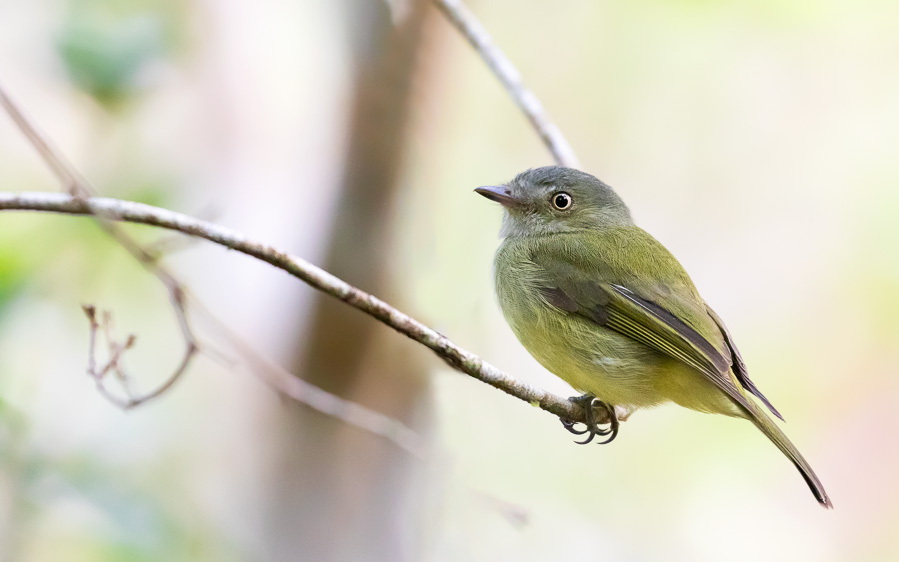
Our main target here will be the range-restricted Wied’s Tyrant-Manakin. Other targets include Yellow-eared and Yellow-browed Woodpeckers, Black-billed Scythebill, Streak-capped and Salvadori’s Antwrens, Pin-tailed Manakin, Rufous-brown Solitaire, Green-winged Saltator and more. A bird that people usually ask about is the Russet-winged Spadebill; although sightings are possible, only 20-30% of birding groups are lucky enough to see it. There are usually many hummingbirds at the pousada’s feeders often including Black Jacobin, Rufous-breasted and Scale-throated Hermits, White-vented Violetear, Frilled Coquette, Brazilian Ruby, Amethyst Woodstar, Violet-capped Woodnymph and more.
Overnight: Santa Teresa
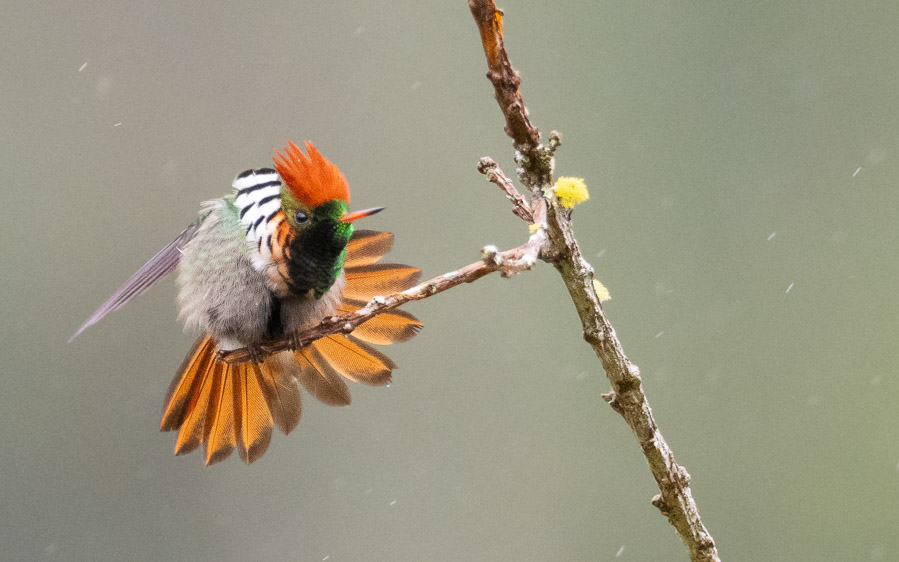
Day 4. Santa Teresa birding and transfer to Vargem Alta
After the morning’s birding at Santa Teresa, we will make the roughly two-hour transfer (75 miles/120 kilometers) to Vargem Alta which is a small village in the mountains of Espírito Santo at 3,300 feet (1,000 meters) high. Most properties in this village are related to agriculture; even so, there are still significant remnants of Atlantic Forest in this region. The most special site is a well-conserved private area (Mata de Caetés) with a marvelous Atlantic Forest patch full of bromeliads, orchids and tall trees. The star here, and our main target, is the Cherry-throated Tanager. This incredible tanager feeds primarily on insects and lives in the canopy. Until February 1998, this species was known from only one specimen deposited in a museum in Berlin, then it was finally rediscovered at Conceição do Castelo (Espírito Santo). After the rediscovery, this species was found at Mata dos Caetés in 2003. The population of this species is thought to be less than 20 individuals, with the majority of them found at Mata dos Caetés where most of the recent records are from. The probability of finding this species is low due, to both the scarcity of the species and the vast area of available habitat. Let us cross our fingers and hope for the best. Encountering this rare species is a privilege reserved for only a few. Aside from the Cherry-throated Tanager, there are over 270 other Atlantic Forest bird species in this area.
Some of the area’s other highlights include Spot-billed Toucanet, Black Hawk-Eagle, White-bibbed Antbird, Yellow-eared and Robust Woodpeckers, Cinnamon-vented Piha and many other Atlantic Forest specials.
Overnight: Vargem Alta
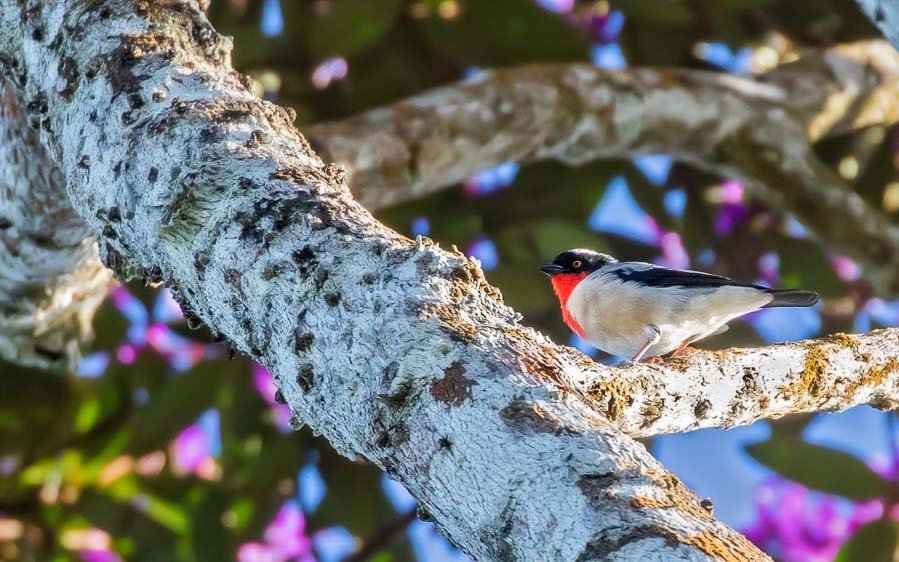
Days 5 and 6. Birding in Vargem Alta
Today we’ll have the whole day to bird the Vargem Alta area which will include morning and afternoon birding sessions.
Overnight: Vargem Alta
Day 7. Morning birding in Vargem Alta and transfer to Caraça Sanctuary
We will have some time for early morning birding before the long, roughly seven-hour (250 miles/400 kilometers) transfer to Caraça Sanctuary. The “Santuário do Caraça” complex comprises about 11,000 hectares and is the property of the Catholic Church. In this private reserve, the vegetation is characterized by a transition from Atlantic Forest to Cerrado, with outcrops of campo rupestre in higher areas. This variation ensures a rich biodiversity, including many mammals like Maned Wolf, Giant Anteater and maybe some species of monkeys, such as Black-fronted Titi Monkey. This site is famous for its great architecture, cozy breakfast area and, of course, the Maned Wolves that sometimes comes to feed close to the facilities in the evening. Here, we generally bird at altitudes ranging from 3,900 to 4,300 feet (1,200 to 1,300 meters). The accommodation facilities are in the forest, with the trails nearby.
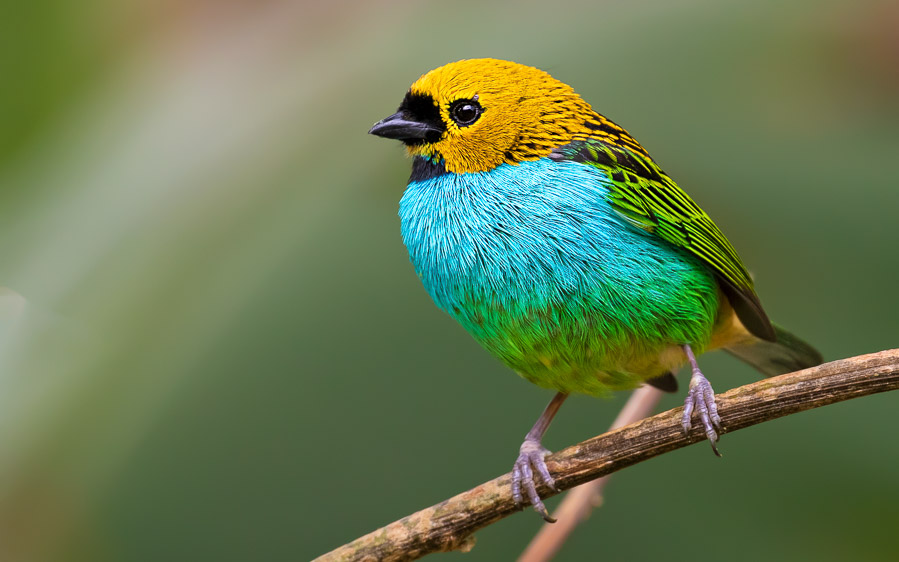
Our main target here is the Serra Antwren and we will have chances to see many other birds such as the Grey-backed Tachuri, Cinnamon, Gilt-edged, Brassy-breasted and Hepatic Tanagers, Serra Finch, Orange-eyed Thornbird, Blackish Rail, White-shouldered Fire-eye, Scaled Woodcreeper, Hyacinth Visorbearer, Rock Tapaculo, Pin-tailed Manakin, Velvety Black Tyrant and many others.
Overnight: Caraça Sanctuary
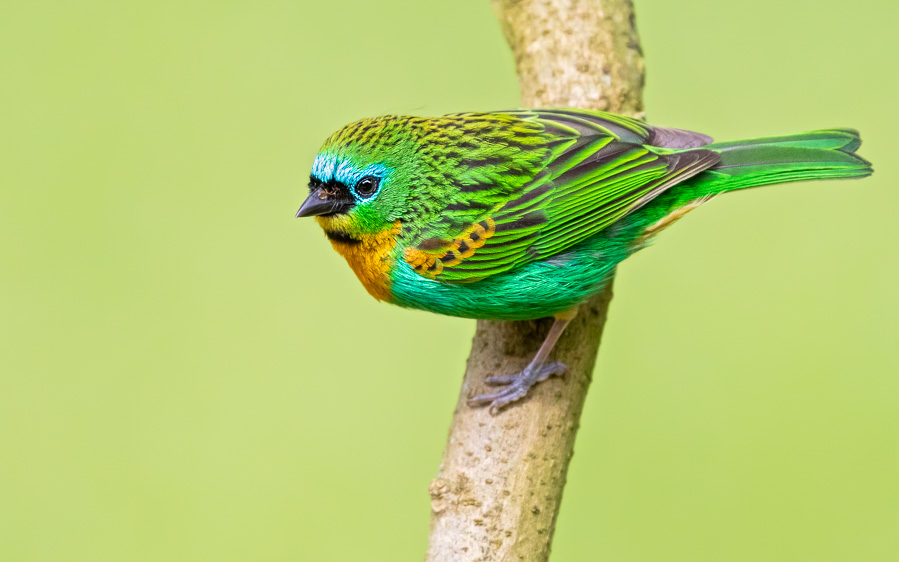
Day 8. Caraça Sanctuary birding
We will have the entire day at our disposal to bird the forest and Cerrado surroundings of Caraça Sanctuary, looking for many of our above-mentioned targets.
Overnight: Caraça Sanctuary
Day 9. Caraça Sanctuary birding and transfer to Serra do Cipó
We’ll have one last opportunity for some pre-breakfast birding around Caraça Sanctuary before we transfer approximately three hours (105 miles/170 kilometers) to Serra do Cipó, for the afternoon’s birding. The Cipó National Park includes 33,800 hectares of designated parklands that were acquired to preserve the endemic-rich plant and animal life of this “serra system”. This is a remarkable place with some fantastic and highly localized birds. It is certainly not to be missed on a visit to the state of Minas Gerais.
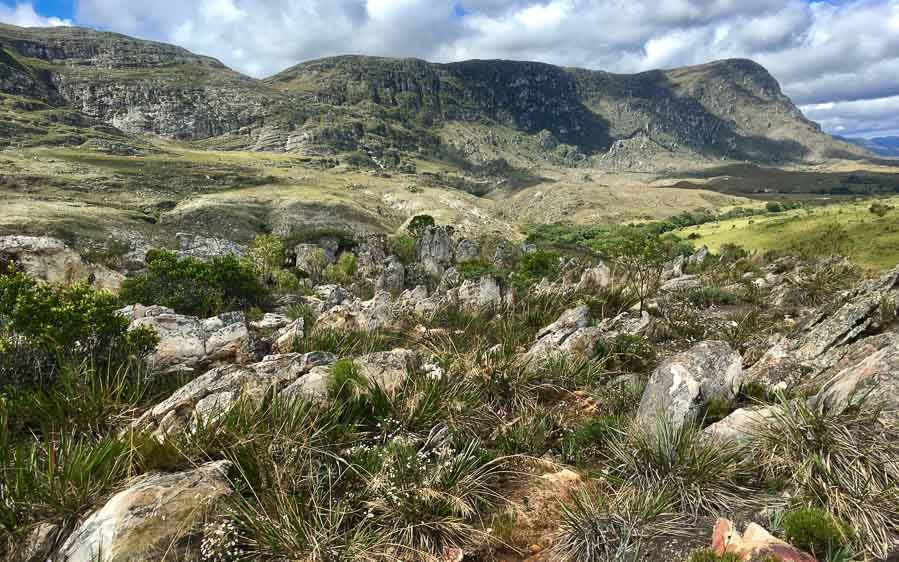
There are two local endemics in this region that are worth highlighting: the Cipo Canastero and the endemic subspecies of Long-tailed Cinclodes. We will have to put in some special effort for both of these species as they are not at all easy to find. Other specials include Rock Tapaculo, Hyacinth Visorbearer, Horned Sungem, Checkered Woodpecker, Lesser Grass Finch, Serra Finch, Blue Finch, Streamer-tailed Tyrant, Stripe-tailed Yellow Finch, Long-tailed Reed Finch and Cinereous Warbling Finch. The area hosts another very interesting target: the range-restricted and recently described (2017) Diamantina Sabrewing, however, only 20-30% of birding groups are lucky enough to see it. We will, of course, also try for Marsh Tapaculo, another ghost. Let us consider ourselves lucky if we even hear this bird!
Overnight: Serra do Cipó
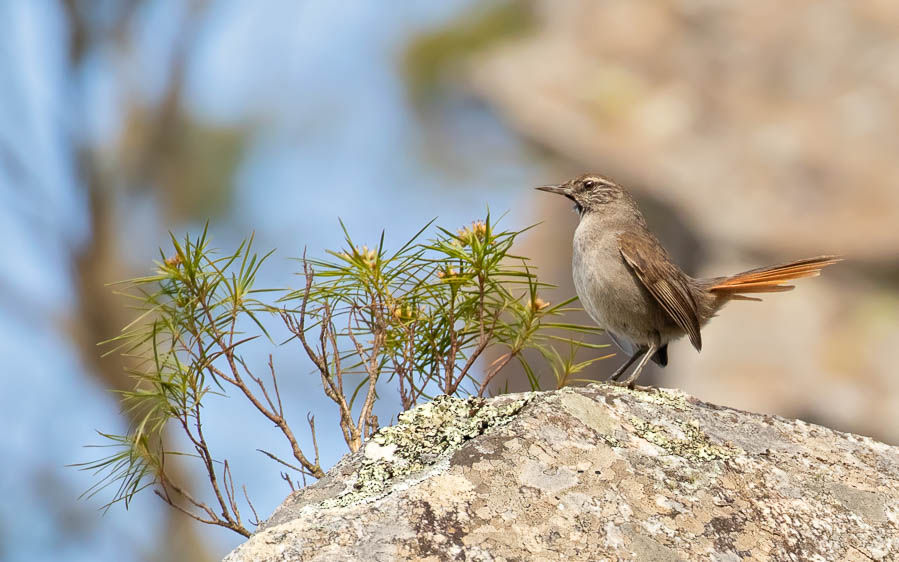
Day 10. Full day’s birding in Serra do Cipó
We will have the full day to bird in Serra do Cipó, looking for many of the targets listed above.
Overnight: Serra do Cipó
Day 11. Transfer to Pompéu
Today we will transfer to Pompéu which is a roughly three-hour drive covering approximately 130 miles (210 kilometers). Pompéu is considered a crake paradise in Brazil. Two brothers, the “Pompeu Twins”, have been taming quite a few species of crakes which means we have good opportunities to see some “true ghosts” such as: Ocellated Crake, Russet-crowned Crake, Grey-breasted Crake and more. Unlike “Serra da Canastra” or “Serra do Cipó”, the habitat here is not protected. We will cover long distances over degraded habitat from our hotel (based in town) to move from patch to patch of well-preserved Cerrado, looking for the many specific targets that we are after.
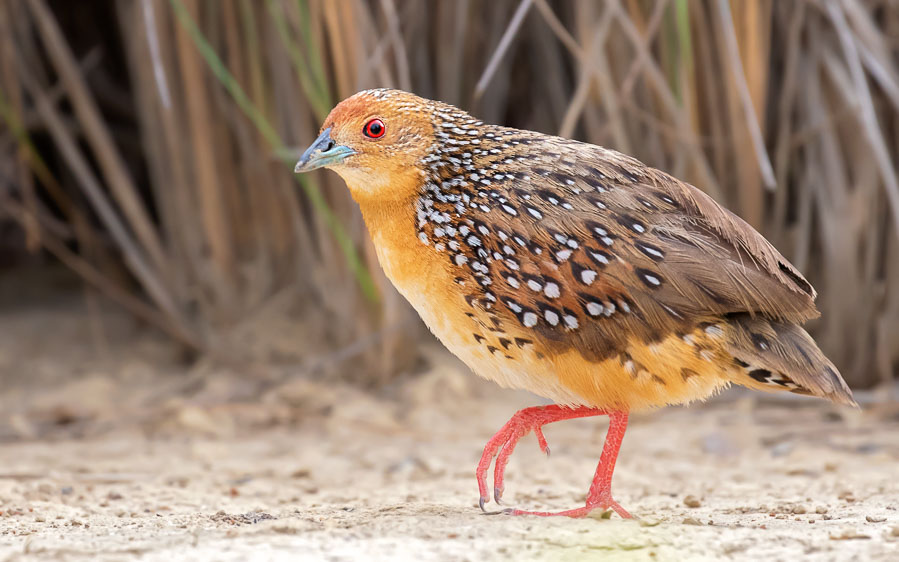
Besides the ghostly crakes mentioned above, a few other species we will look for include Coal-crested Finch, Chapada Flycatcher, Henna-capped Foliage-gleaner, Checkered Woodpecker, Black-faced Tanager, Least Nighthawk, Caatinga Puffbird and more.
Overnight: Pompéu
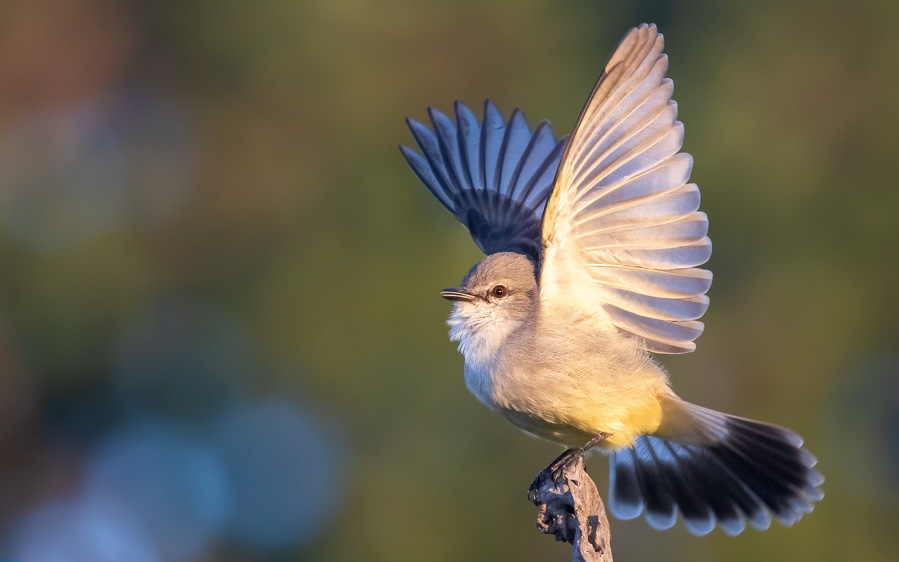
Day 12. Morning birding in Pompéu and transfer to Serra da Canastra
Today we transfer for approximately five hours (200 miles/320 kilometers) to the Serra da Canastra National Park, southwest of Minas Gerais, which has some of the most breathtaking and seldom-seen landscapes in Brazil. The area covers almost 200,000 hectares and spans six municipalities: São Roque de Minas (where we will be based), Vargem Bonita, Sacramento, Delfinópolis, São João Batista do Glória and Capitólio. The region is the cradle of many rivers that help form the São Francisco and Paraná basins. The landscape alternates between rocky fields (campo rupestre) full of delicate flowers, typical Cerrado (open grasslands and wooded savanna), and gallery forests with lush Atlantic vegetation. It is in these environments that endangered animals such as Giant Anteater, Maned Wolf, Giant Armadillo and Brazilian Merganser are protected.
Our main target here is, of course, the Brazilian Merganser, and our first day will be solely dedicated to finding it. Depending on local up-to-date information, the guide will decide if the group will begin the search in the lowlands or highlands. Due to its rarity and sensitivity, it is forbidden to use playback for the merganser. The strategy here is to choose one of its many territories or feeding areas and wait – patience is key. Besides the merganser, there are several Cerrado birds that we will look for in the highlands (plateau). To access this area of the park, we will have to drive five miles on a treacherous dirt road until we reach the plateau. Upon entering the park, we will bird along the main road, looking for various Cerrado specials.
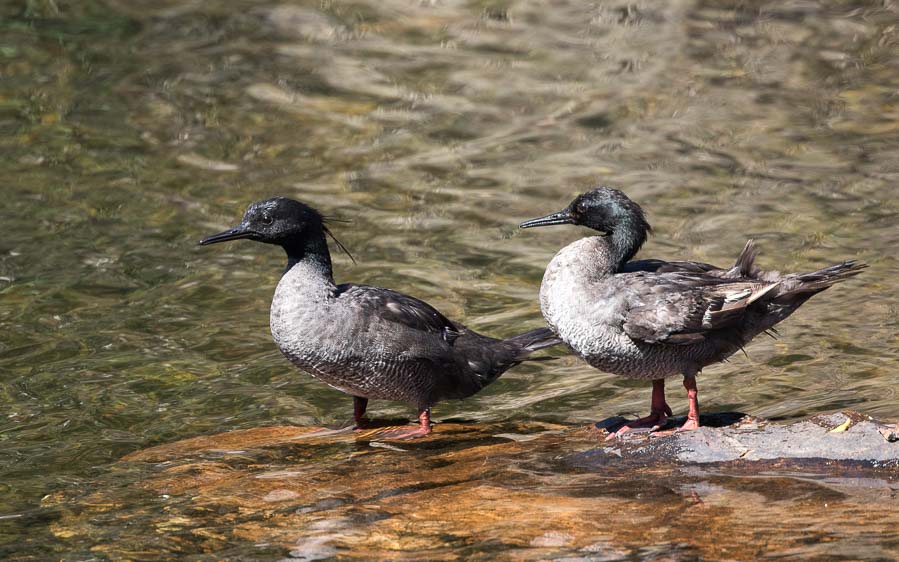
In addition to having good chances of seeing the rare Brazilian Merganser, there are several other species that live in this high altitude Cerrado, such as Campo Miner, Grass Wren, Cock-tailed Tyrant, Sharp-tailed Grass Tyrant, and Black-masked Finch, amongst others. We have great chances of finding Brasilia Tapaculo within streams in the high parts of the mountain range. There are also some areas of gallery forest where we may find the beautiful Helmeted Manakin. Other possible species include Yellow-rumped Marshbird, White-striped Warbler, Ochre-breasted Pipit, Golden-capped Parakeet, Greater Rhea, Shrike-like Tanager, Cinereous Warbling-Finch, Pampa Finch, Red-legged Seriema, Toco Toucan, White-rumped Tanager, White-wedged Piculet, Large-billed Antwren, Collared Crescentchest, Firewood-gatherer and many more.
Overnight: Serra da Canastra
Days 13-14. Full day’s birding in Serra da Canastra
Today we have the exciting prospect of the full day birding the Serra da Canastra area.
Overnight: Serra da Canastra
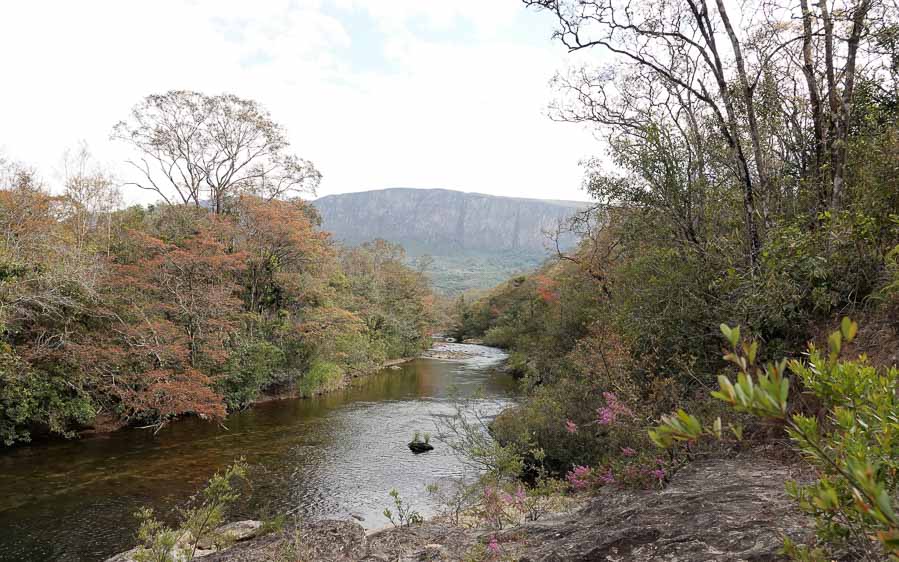
Day 15. Transfer to Belo Horizonte for departure
We have another long transfer ahead of us today as we cover 225 miles (360 kilometers), which should take around five hours, to Belo Horizonte from where we will depart after an exciting two weeks of remote Brazilian birding.
Please note that the itinerary cannot be guaranteed as it is only a rough guide and can be changed (usually slightly) due to factors such as availability of accommodation, updated information on the state of accommodation, roads, or birding sites, the discretion of the guides and other factors. In addition, we sometimes have to use a different guide from the one advertised due to tour scheduling and other factors.
Download ItineraryGENERAL INFORMATION ABOUT BRAZIL CAN BE READ HERE.

